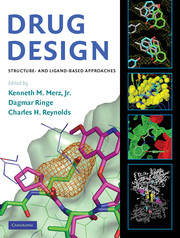Book contents
- Frontmatter
- Contents
- Contributors
- Preface
- DRUG DESIGN
- 1 Progress and issues for computationally guided lead discovery and optimization
- PART I STRUCTURAL BIOLOGY
- PART II COMPUTATIONAL CHEMISTRY METHODOLOGY
- PART III APPLICATIONS TO DRUG DISCOVERY
- 12 Computer-aided drug design: a practical guide to protein-structure-based modeling
- 13 Structure-based drug design case study: p38
- 14 Structure-based design of novel P2-P4 macrocyclic inhibitors of hepatitis C NS3/4A protease
- 15 Purine nucleoside phosphorylases as targets for transition-state analog design
- 16 GPCR 3D modeling
- 17 Structure-based design of potent glycogen phosphorylase inhibitors
- Index
- References
15 - Purine nucleoside phosphorylases as targets for transition-state analog design
from PART III - APPLICATIONS TO DRUG DISCOVERY
Published online by Cambridge University Press: 06 July 2010
- Frontmatter
- Contents
- Contributors
- Preface
- DRUG DESIGN
- 1 Progress and issues for computationally guided lead discovery and optimization
- PART I STRUCTURAL BIOLOGY
- PART II COMPUTATIONAL CHEMISTRY METHODOLOGY
- PART III APPLICATIONS TO DRUG DISCOVERY
- 12 Computer-aided drug design: a practical guide to protein-structure-based modeling
- 13 Structure-based drug design case study: p38
- 14 Structure-based design of novel P2-P4 macrocyclic inhibitors of hepatitis C NS3/4A protease
- 15 Purine nucleoside phosphorylases as targets for transition-state analog design
- 16 GPCR 3D modeling
- 17 Structure-based design of potent glycogen phosphorylase inhibitors
- Index
- References
Summary
INTRODUCTION
Among the most powerful enzyme-targeted drugs are those that bear a strong resemblance to the transition state of the chemical reaction undergoing catalysis. This chapter illustrates that experimental determination of enzymatic transition-state structure permits chemically stable analogs to be designed. Mimics of these transition states exhibit binding affinities exceeding those of the substrates by factors of greater than 106. To appreciate this approach to drug design, it is necessary to understand the nature of transition-state formation and how it relates to the strong binding interactions between enzymes and transition-state analogs.
Enzymatic transition-state formation
All chemical reactions proceed through at least one transition state, an unstable structure of maximal energy along the reaction coordinate. Having a lifetime of under 100 fs (10-13 s), the time required for a single bond vibration, the transition state is the most unstable species along a chemical reaction coordinate. In the absence of a catalyst, the probability of transition-state formation is extremely low. Enzymes achieve great catalytic reaction rates by providing appropriately positioned functional groups within the active site, which interact with and distort the substrate toward the transition state by dynamic motions of the complex.
Although the physical means of enzymatic transition-state formation remain the subject of scientific debate, several theories have been proffered. In the early 1940s, Linus Pauling postulated that enzymes bind most optimally not to the normal substrate molecule but rather to the substrate molecule in a strained configuration corresponding to the “activated complex.” He suggested that various attractive forces with the enzyme cause the substrate to adopt the strained configuration, thereby favoring the chemical reaction and accounting for the lowered activation energy of the catalyzed reaction.
- Type
- Chapter
- Information
- Drug DesignStructure- and Ligand-Based Approaches, pp. 215 - 247Publisher: Cambridge University PressPrint publication year: 2010



